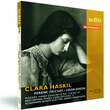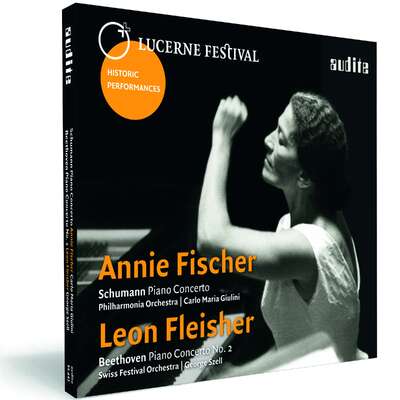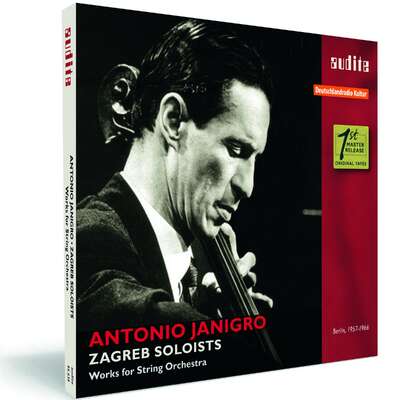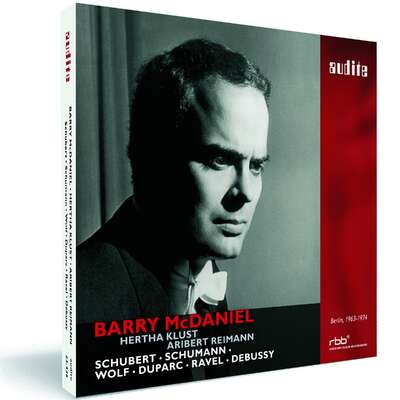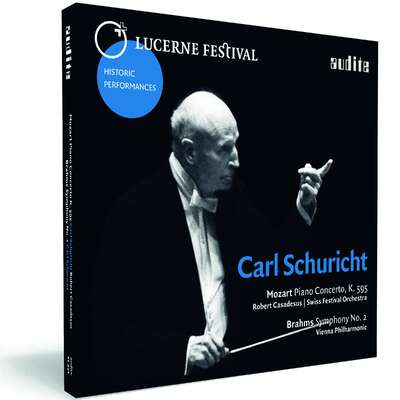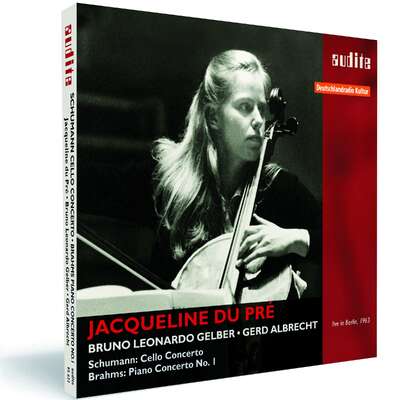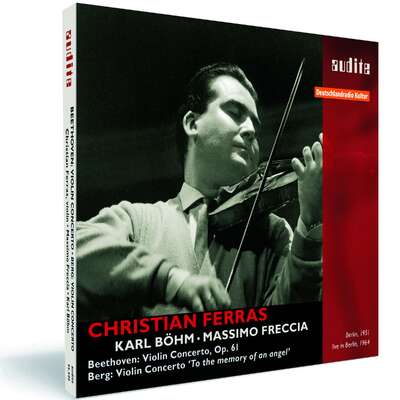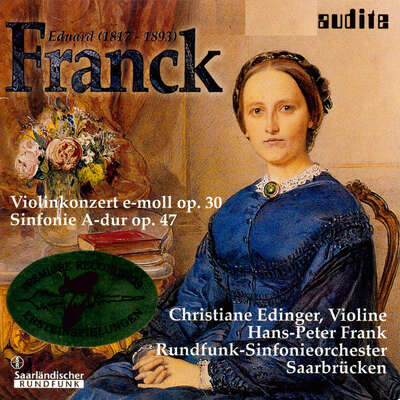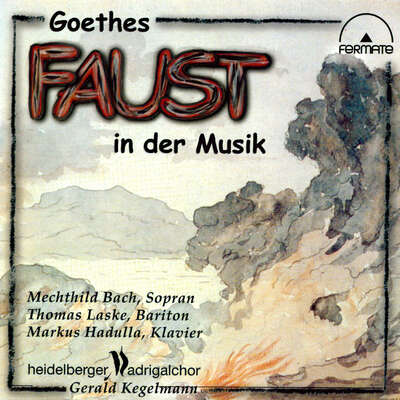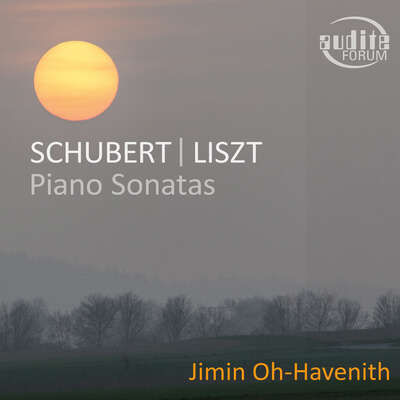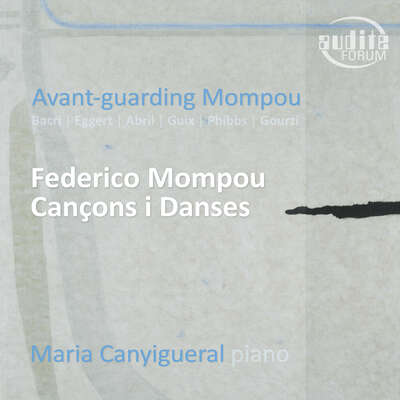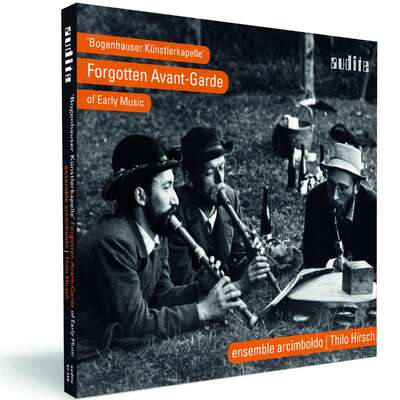
Die Aufnahmen Clara Haskils aus den 1950er Jahren besitzen Kultstatus. In diesen historisch und künstlerisch gleichermaßen bedeutenden Tondokumenten lässt sich die Verbindung der besten Eigenschaften der französischen Klavierschule – der Haskil als Schülerin Lazare Lévys und Alfred...mehr
"Die Wahrheit des Klavierspiels" (Westdeutsche Allgemeine Zeitung)
Titelliste
Details
| Clara Haskil plays Mozart, Beethoven and Schumann | |
| Artikelnummer: | 23.421 |
|---|---|
| EAN-Code: | 4022143234216 |
| Preisgruppe: | BCA |
| Veröffentlichungsdatum: | 13. März 2009 |
| Spielzeit: | 133 min. |
Zusatzmaterial
Informationen
Die Aufnahmen Clara Haskils aus den 1950er Jahren besitzen Kultstatus. In diesen historisch und künstlerisch gleichermaßen bedeutenden Tondokumenten lässt sich die Verbindung der besten Eigenschaften der französischen Klavierschule – der Haskil als Schülerin Lazare Lévys und Alfred Cortots angehörte – mit der Ausstrahlung einer ungewöhnlichen Persönlichkeit studieren, deren Auftritte der Kritiker Antoine Goléa einmal mit den Worten beschrieb, die Musik selbst sei zu Gast gewesen. Besonders berühmt waren Haskils subtile Mozart-, Beethoven- und Schumann-Interpretationen. Die hier erstmals unter Verwendung der Originaltonbänder remasterten und veröffentlichten Studioaufnahmen und Konzertmitschnitte großer Klavierkonzerte Mozarts (KV 459 und 466) und Beethovens (op. 58) sowie zweier Solowerke Schumanns (Abegg-Variationen op. 1 und eine Auswahl aus den „Bunten Blättern“ op. 99) zeigen die Sensibilität und Natürlichkeit von Haskils Spiel, das Ferenc Fricsay mit der Fähigkeit des Singens auf dem Klavier verglich. Darüber hinaus bietet diese audite-Veröffentlichung die Gelegenheit, Mozarts berühmtes Konzert d-moll KV 466 im direkten Vergleich des bisher unveröffentlichten Konzertmitschnitts und der nur einen Tag später entstandenen Studioproduktion aus dem Januar 1954 zu hören.
Fricsay und das Radio-Symphonie-Orchester Berlin erwiesen sich hier einmal mehr als kongeniale Partner einer Jahrhundertpianistin.
Zu dieser Produktion gibt es wieder einen Producer's Comment – das heißt, einen unmittelbaren Eindruck des Produzenten Ludger Böckenhoff.
Die Produktion mit Clara Haskil ist Teil unserer Reihe „Legendary Recordings“ und trägt das Qualitämerkmal „1st Master Release“. Dieser Begriff steht für die außerordentliche Qualität der Archivproduktionen bei audite. Denn allen historischen audite-Veröffentlichungen liegen ausnahmslos die Originalbänder aus den Rundfunkarchiven zugrunde. In der Regel sind dies die ursprünglichen Analogbänder, die mit ihrer Bandgeschwindigkeit von bis zu 76 cm/Sek. auch nach heutigen Maßstäben erstaunlich hohe Qualität erreichen. Das Remastering – fachlich kompetent und sensibel angewandt – legt zudem bislang verborgene Details der Interpretationen frei. So ergibt sich ein Klangbild von überlegener Qualität. CD-Veröffentlichungen, denen private Mitschnitte von Rundfunksendungen zugrunde liegen, sind damit nicht zu vergleichen.
Besprechungen
Fanfare | Volume 33, Mo. 5 - May/June 2010 | Boyd Pomeroy | 1. Mai 2010
Another winner in Audite's invaluable ongoing series of historic reissues from 1950s German radio archives. As usual, the new remasterings derive fromMehr lesen
Mozart's piano concertos, or a few of them, were central to Haskil's limited repertoire. Her performance style in this music is well known – precise fingerwork, a rather small-scale lyricism characterized by great subtlety of tonal and rhythmic nuance, and a nervous temperament that could make for rather accident-prone concerts. In her day, many regarded her as the epitome of Mozartian style. She must have enjoyed working with Fricsay, judging by their number of preserved collaborations, both studio and live – including at least three in K 459 alone. However, his conducting does her few favors in the first movement of the same – the tempo slightly too staid; a stolid impression of excessive legato and a general lack of light and shade not making a good foil for Haskil's characteristic understatement. (She also perpetuates an obvious score misprint in the recapitulation of the secondary material – a jarring D instead of the correct high F in bar 318, for those curious.) This movement benefits from living a little more dangerously; for modem-piano versions in the up-to-tempo quick march it really needs, hear Goode/Orpheus (Nonesuch), Kocsis/Budapest Festival (Philips), or Schiff/Salzburg Camerata (Decca). Things improve greatly in the remainder of the concerto, however, the second movement taken at a real Allegretto, and a wonderfully elegant finale incorporating (unusually for its time) a stylish improvised Eingang before the first return of the main theme.
The D-Minor Concerto, K 466, must have been Haskil's single most-performed piece, to judge from the bewildering proliferation of performances on CD. The studio version with Fricsay here has previously appeared on DG, but the new Audite remastering is clearly superior in every way. The performance, however, leaves a rather soft-focused impression, the music's exceptional dramatic qualities recollected in a little too much tranquility (though the subtly varied shadings of the first movement's recurrent solo entry are vintage Haskil). In comparison, the previous day's live performance seems to provide a "shot in the arm" for both Haskil and Fricsay, with a nervous intensity missing from the studio version. Even so, she displays more D-Minor fire in a live 1956 performance with Munch in Boston (Music & Arts, though the harsh sound is a drawback). But the limitations of Haskil's approach are evident if we cast a wider comparison to other pianists from the early-mid 1950s: Serkin/Ormandy (1951, Sony), Lefébure/Casals (1951, Sony), Kraus/Boskovsky (1955, Japanese EMI), Kempff/Karajan (live, 1956, Audite) – all in their different ways offering playing (and conducting) of stronger character and greater dramatic reach.
I've left the best concerto performance for last: Beethoven's Fourth with the under-represented American maestro Dean Dixon. What a difference a conductor can make! Haskil left a number of versions of this concerto between the years 1947 (with Carlo Zecchi for Decca) and 1959 (with Erich Schmid in Beromünster), of which the best conducted are the present version and a 1952 Vienna performance with Karajan (Tahra, but in much less good sound). Dixon's direction is superb – exceptionally alert, with a trenchancy and precision of orchestral execution far above routine, along with an imaginative response to the score's poetry that brings out the best in Haskil, in a performance of radiant long-lined lyricism. This is truly inspired music-making, soloist and conductor reacting to one another in little hair-trigger nuances of timing (for a small but telling example, listen to the turn to minor at the beginning of the first-movement development, the way Haskil reacts to the sudden emotional transformation of the ubiquitous eighth-note upbeat figure, passed from orchestra to soloist – so simple, but the stuff of truly great collaboration). Altogether one of Haskil's best-ever live concerto performances, and alone worth the price of the set.
Schumann's technically undemanding Bunte Blätter finds Haskil in her element, the intimate lyrical impulses conveyed with wonderful spontaneity, even if she is sometimes reluctant to give Schumann's weightier moods their due (by what stretch of the imagination does her Albumblatt No. 4 qualify as "sehr langsam"?). The dazzling Abegg Variations reminds us that her technique was, in its way, the equal of anyone's. Her airborne fantasy in this piece was truly sui generis.
As usual with this series, the recorded sound is stunningly good for its vintage (both studio and live performances), raising the bar for other labels' historical restorations. Indeed, I'm tempted to say that this is now the finest-sounding representation of Haskil's art available. Highly recommended to newcomers and seasoned Haskilians alike.
France Musique
| mardi 26 janvier 2010 | Frédérique Jourdaa | 26. Januar 2010
BROADCAST Grandes figures
Génération 1810 par Arièle Butaux (7/9) L'enfance des génies
Sendebeleg siehe PDF!Mehr lesen
Kulimu | 35. Jg. 2009 Heft 2 | Ulrich Alberts | 1. November 2009 In der Musik versunken
Audite in Detmold ist die sehr begrüßenswerte Veröffentlichung vonMehr lesen
Pizzicato | N° 195, 9/2009 | Alain Steffen | 1. September 2009 Aus den Archiven
Vier weitere Veröffentlichungen aus dem historischen Archiv, wobei aber nur zwei wirkliches Interesse verdienen. Kaum erwähnenswert bleibt KarlMehr lesen
Auch Fricsays Einspielung von Rossinis Stabat Mater gehört nicht zu den Meilensteinen dieses genialen Dirigenten. Und das liegt nicht einmal am Dirigenten selbst, der allen Klischees zum Trotz einen spannenden und reliefreichen Rossini dirigiert und sich demnach nicht mit reinem Schönklang zufrieden gibt. Allerdings passen die vier Solisten, insbesondere Maria Stader und Ernst Haefliger stimmlich ganz und gar nicht zu Rossinis geistlichem Werk. Da ist einfach zu viel Mozart und zu wenig Rossini. Zudem gehen beide Sänger bis an Grenzen, die uns dann einige unschöne Momente bescheren. Etwas besser sind Marianna Radev und Kim Borg in den tiefen Registern. Doch der Mangel an Homogenität im Solistenquartett wirkt sich durchgehend negativ auf die Gesamtkonzeption aus.
Herausragend dagegen ist die Einspielung der Klavierkonzerte Nr. 19 & 20 von W.A. Mozart. Man kennt Haskils Stil, aber in jeder ihrer Aufnahmen betört diese Pianistin den Zuhörer mit ihrer ungeheuren Sensibilität und ihrem Sinn für Schönheit und Stil. Fricsay, selbst einer der großen Mozart-Interpreten der Fünfzigerjahre, ist ein idealer Partner für Clara Haskil und so präsentieren beide einen hochrangigen Mozart, der nichts von dem zuckersüßen Wolfgang wissen wollte und demnach durch seine Modernität seiner Zeit weit voraus war. Und dennoch: Die schönste Aufnahme dieses Doppelalbums ist Beethovens 4. Klavierkonzert das unter Haskils Fingern eine schier göttliche Dimension erreicht. Obwohl der heute vergessene Dean Dixon sich Beethoven eher mit einer sehr dynamischen und sportlichen Leseart nähert und so einem Konzept nachgeht, das sich grundlegend von dem einer Clara Haskil unterscheidet, so bildet gerade diese unterschiedliche Basis ein solides Terrain für eine der sicherlich spannendsten Beethoven-Auseinandersetzung der Discographie. Dean Dixon war übrigens der erste afroamerikanische Dirigent, der an der Spitze von renommierten Symphonieorchestern stand. Wegen seiner Hautfarbe hatte er es allerdings in Amerika recht schwer und so konzentrierte er sich hauptsächlich auf Australien und Europa. 1970 kehrte er allerdings nach Amerika zurück und wurde triumphal gefeiert. Der 1915 in New York geborene Dirigent starb 1976 in der Schweiz.
www.concertonet.com | 07/25/2009 | Sébastien Foucart | 25. Juli 2009
L’indispensable collection d’archives d’audite s’enrichit d’unMehr lesen
Classica – le meilleur de la musique classique & de la hi-fi | Juillet/Août 2009, n° 114 | Jacques Bonnaure | 1. Juli 2009 Clara Haskil
Les enregistrements Audite proviennent des archives de la RIAS de Berlin.Mehr lesen
Diapason | Juillet/Août 2009 - N° 571 | Alain Lompech | 1. Juli 2009
Transférées pour la première fois depuis les bandes originelles conservées par la Radio allemande, ces interprétations sonnent mieux que dans lesMehr lesen
Dirigé d'une façon admirable en tout point par Dean Dixon, le Concerto n° 4 de Beethoven est le meilleur de ceux que l'on possède de la musicienne, et l'un des rares qui puissent tenir face à Kempff/ Van Kempen (DG). Plus les années passent et plus son Mozart singulier reprend de la vigueur, pour s'imposer, bien au-delà des querelles stylistiques, comme le grand modèle que n'ont fait qu'approcher ses contemporains Edwin Fischer, Arthur Rubinstein et Arthur Schnabel. Tant de naturel, de fluidité, d'emportements soudains, tant de virtuosité ailée et parfois féroce (en public plus qu'en studio), tant de vocalité dictant sa loi à des orchestres sous le charme puissant d'un jeu si sobrement intense étaient la marque de fabrique d'une pianiste romantique fort heureusement égarée chez Mozart.
Scherzo | Julio 2009 | Enrique Pérez Adrián | 1. Juli 2009
Audite Edición Fricsay
Una Joya
Prosigue el sello alemán Audite (distribuidor: Diverdi) con su magníficaMehr lesen
Gramophone | July 2009 | Jeremy Nicholas | 1. Juli 2009
Legacies and rewards
Jeremy Nicholas welcomes the reissue of rediscovered recordings by a forgotten New Zealand virtuoso
From Audite come two discs of Clara Haskil remastered from original broadcast tapes recorded by Deutschlandradio in 1953 and 1954. Mozart's F majorMehr lesen
Tapes from South West German Radio (SWF) furnish Hänssler Classic's release of Géza Anda in four concertos, studio recordings made between 1952 and 1963. In the first two movements of Chopin's E minor Concerto (with the SWR Symphony Orchestra under Ernest Bour) Anda introduces ideas I have never heard from another and with which I was quite taken – deft little (unmarked) staccato scale runs, for instance, and a dramatically convincing ritenuro before the return of the main subject in the first movement. The finale is just this side of lethargic to be vivace. Anda's similarly light-fingered, sparingly pedalled playing gives the Schumann Concerto an almost Mendelssohnian character. Rachmaninov's Second has its sumptuous Romanticism pared down – chilly is the word that springs to mind – while the conductor Hans Rosbaud and Anda have not, apparently, agreed on every aspect of tempo if the shambolic passage after the first movement's alla marcia section is anything to go by. Far more successful is a taut and fiery Brahms Second with the same forces.
Nevertheless, given the choice, I'd rather hear Arthur Rubinstein than Anda any day in the Schumann and Brahms. In live performances from 1962 and 1964, recorded in the RAI concert halls in Turin and Naples, the septuagenarian Rubinstein invests both works with a vigorous muscularity that is quite remarkable. There again, few knew better than him how to tug at the heart strings and the Schumann, though in not quite such focused sound as the Brahms, has a first movement in which Rubinstein takes due note of Schumann's allegro affettuoso, absent both in Anda's performance (allegro) and in Hänssler's inaccurate track-listing (allegro non troppo).
Medici Masters have found a good quality source for the Chopin and Liszt recital given in Tokyo in April 1964 by Georges Cziffra (1921-94). Cziffra in Chopin is not always persuasive. Here, by and large, he is on his best behaviour and, indeed, often illuminating (F minor Fantasie, Scherzo No 2, Ballade No 4) offering soberly lyrical readings coloured with passages of trademark brilliance (fabulous repeated notes in the E flat Waltz, Op 18, and an adrenalin-drenched coda of the Ballade). Though he frequently programmed the work, the majestic character of the A flat Polonaise mysteriously eluded him, as it does here, its central section reduced to a flashy left-hand octave exercise. The remaining four items are of Liszt. The opening bars of the first of these, the Rhapsodie espagnole, are like hearing someone who has just had the handcuffs taken off. There is nothing quite like Cziffra playing Liszt. He simply leaves you smiling, shaking your head in disbelief, as he dazzles the senses. At 11'19" the Rhapsodie must be one of the fastest ever recorded – more furiously driven even than Barere – while for pure vehemence the Hungarian Rhapsody No 6 bids to outdo Horowitz's famous recording. Neither scores are short of Cziffra's own textual embellishments. Film of this Tokyo performance of the Grand galop chromatique, a Cziffra party piece, has been circulating for years. It's one of the great high-wire acts that only someone with the same abnormal muscular reflexes could equal. The sound throughout is fine, though, to my ears, the piano's crystalline treble seems not married happily to the comparatively muddy bass voicing.
Cziffra's posthumous legacy is, thankfully, being well taken care of. No such fate has hitherto befallen the New Zealand pianist Richard Farrell, whose tragic early death robbed us of a major talent (he was killed in a car crash near Arundel, Sussex, in 1958 at the age of 32). Except for a brief appearance on EMI's short-lived Phoenixa label in the early 1990s, I don't think any of Farrell's recordings have been available since his death. Many collectors treasure his account of Rachmaninov's Corelli Variations which is promised on a future volume of Farrell's complete recordings by the producers of this immaculately presented and remastered first volume (its two discs are smuggled into a single CD jewel case). All the items were released in mono on the Pye label in the UK and New Zealand. Here, the two concertos (with the Halle under George Weldon) are taken from their stereo Mercury Living Presence edition, released only in America; the Brahms solos are in stereo (previously unpublished), the Grieg items in mono. What we have here are some of the most beautiful recorded performances of the time bathed in what I can only describe as that warm, intimate piano tone familiar from the LP era now all too often lost to clinical digitisation; the Grieg Concerto (as poetic and full-blooded as they come), the four Brahms Ballades (straight to the top of my personal favourites) and 16 Waltzes (ditto), Grieg's Ballade (perhaps the most convincing version on disc of this awkward, flawed work), nine popular Lyric Pieces (how one wishes there were more) and Liszt's E flat Concerto (a magisterial “first movement”, an unusually limpid quasi adagio and a thrilling finale). Buy this release. You'll be richly rewarded.
Audiophile Audition | June 30, 2009 | Gary Lemco | 30. Juni 2009
Recordings from the studio and the concert hall 1953-1954 by the inimitableMehr lesen
Diverdi Magazin | 182/ junio 2009 | Roberto Andrade | 1. Juni 2009
El piano que canta
Nueva muestra del arte de Clara Haskil en Audite
Ferenc Fricsay caracterizó el arte de Clara Haskil con la expresión que encabeza este comentario. La gran pianista rumana había aprovechado muyMehr lesen
La única limitación de este precioso doble CD que Audite ofrece en muy buenas condiciones de sonido es que el repertorio que toca la Haskil es más que familiar. Pero quienes no posean los tres conciertos aquí reunidos, 19 y 20 de Mozart (éste, por duplicado) y Cuarto de Beethoven, no deben dudar ni un instante en hacerse con esta joya. Las colaboraciones de Haskil y Fricsay en los Conciertos mozartianos (existe también el 27, DG) son históricas y en el Cuarto de Beethoven, Dean Dixon obtiene de la Sinfónica de la RÍAS muy buen rendimiento y acompaña con pleno acierto.
La doble propuesta que Audite formula para el Concierto no 20 de Mozart está fechada en días sucesivos, 10 y n de enero de 1954, aquélla en público y ésta en estudio. La comparación apenas muestra diferencias musicales aunque sí se aprecia la superior acústica de estudio en la Iglesia de Jesucristo en Berlín-Dahlem. Los complementos son todos de Schumann: Variaciones ABEGG op. 1, tres Bunte Blätter op. 99 y cinco Hojas de álbum. Música exquisita en estupenda interpretación que pone de relieve la sensibilidad de la Haskil para las miniaturas y para el piano de Schumann. Magníficos comentarios de Wolfgang Radien. Un nuevo éxito de Audite.
International Piano | June 2009 | 1. Juni 2009
Rezension siehe PDFMehr lesen
Westdeutsche Allgemeine Zeitung | Wochenende, 15.05.200 | Hajo Berns | 15. Mai 2009 Die Wahrheit des Klavierspiels
„In zwei Wochen musst du Clara Mozart spielen hören. Dann wirst duMehr lesen
Journal de la Confédération musicale de France | Mai/Juin 2009 | Jean Malraye | 1. Mai 2009
Les CD de Jean Malraye
Concertos
MOZART par HASKIL et FRICSAY: un plaisir rare à goûter sans restriction.Mehr lesen
Universitas | Mai 2009 | Adelbert Reif | 1. Mai 2009
„Woher kommt überhaupt mein Erfolg - und es gibt Länder, wo ich einenMehr lesen
www.classicstodayfrance.com | Avril 2009 | Christophe Huss | 1. April 2009
Il va bientôt falloir un doctorat pour faire le tri dans les 5000Mehr lesen
www.codaclassic.com | April 2009 | 1. April 2009
Rezension siehe PDFMehr lesen
andante | April 2009 | 1. April 2009
Rezension siehe PDFMehr lesen
La Musica | April 2009 | 1. April 2009 Ferenc Fricsay Editions
Rezension siehe PDFMehr lesen
